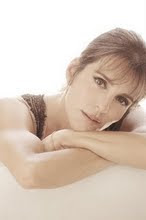I can see many of my readers have been asking questions about Haute Couture. So I've looked up something we wrote with Carla a couple of years ago, for a book we have not yet published... I've posted it in this blog before, but here it goes again...
"Although it is considered prestigious and where one can witness a creator in all his strength and depth, not many keep their Haute Couture ateliers working. It's becoming hard to attract clients that can pay the high costs of a hand-sewn and embroidered dress, which requires a toile, at least three fittings and many hours of work. Let's not forget that Hollywood actresses get the dresses for award shows and red carpets on loan, which reduces terribly the spectrum of real clients. The arrival and expansion of prêt-à-porter, plus the rising costs have made the "ceremony" of fitting and buying an Haute Couture dress a luxury for the few. A long time ago, clients would spend months vacationing in Europe so that they could be near and available in Paris for their fittings. Complete wardrobes, with wedding gowns, party and cocktail dresses included, would be ordered. It was another time altogether. According to October's 2008 edition of US Vogue only 200 people used to buy Haute Couture dresses in Paris. This, of course, before the economic meltdown.
To be considered an Haute Couture designer, he or she must belong to the Chambre Syndicale de la Haute Couture, a division of the French Ministry of Industry, and comply with the rules associated with the title: preside an atelier employing 20 people at least, where complete handmade pieces should be made only upon request. These ateliers are divided into specialized areas such as Tailleur (tailoring), Flou (soft dressmaking) or Embroidery, because it is not the same to work on tweed than on silk or chiffon. Each area is supervised by a Director of Couture who is in charge of leading the whole team into "building" and giving shape to what the designer of the Maison might have sketched.
The seamstresses and tailors of these workrooms are real artists. As surgeons, with their clinical white coats, they are trained to treat our bodies as a sum of problems to solve, unravelling details and hidden flaws, so that in the end, the final result fits us as a glove. It is said that a Chanel jacket takes 150 hours to make and at least three fittings.
Haute Couture designers must present a minimum of 25 looks, twice a year, in January and July. Before World War II, there were 200 Haute Couture designers. Now only 11 bear the title. A designer who calls himself an Haute Couturier without the approval of the Chambre could be taken to jail, because it is an appelation contrôlée or trade mark.
Because they are extremely expensive and artisanal, Fashion Houses today trust in their prêt-a-porter lines, perfumes and accessories to make their business work. Keeping the ateliers has more to do with a creative caprice that strengthens the whole label. How? Because by dressing style icons worldwide they pour publicity into their more popular lines."



.jpg)
No comments:
Post a Comment